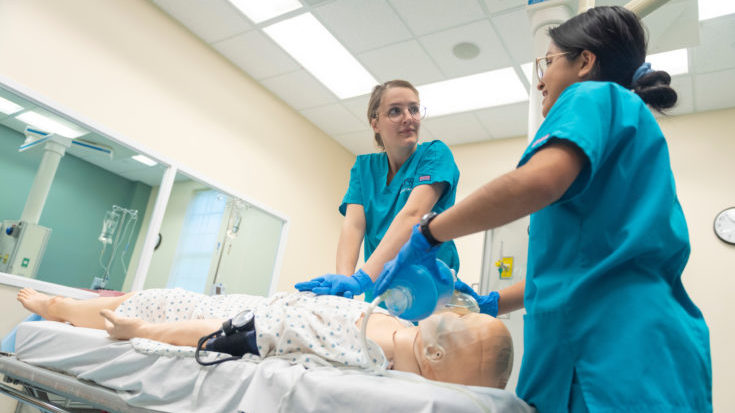
June 16, 2023
RTs who graduated from their respiratory care programs within the past 10 to 15 years likely did some of their clinical training in a simulation lab. The idea is to use human patient simulators to give health care students a chance to practice their new skills in a safe environment before applying those skills to real patients.
Over the years, clinical simulation has become more and more sophisticated and is now being used not just in educational programs but in hospitals as well to train physicians, nurses, RTs, and other hands-on clinicians in new skills and keep them current on existing skills too.
Samantha Davis, MSRC, RRT, RRT-NPS, CHSE, is on the cutting edge of this technology. In addition to working as a bedside therapist at Henry Ford Health in Detroit, MI, she now develops virtual reality games for a company called Oxford Medical Simulation (OMS).
An excellent foundation
Davis says she decided to become an RT after working as a nursing assistant in a local hospital and seeing RTs in action in the ICUs. “The fast-paced nature of critical care drew me to the profession,” she said. “I’ve stayed because I love being a respiratory therapist. There are endless opportunities to advance knowledge, hone skills, and refine expertise in various settings.”
She worked as a neonatal-pediatric therapist for six years and then taught in an adjunct capacity for four years before embarking on her journey with clinical simulation, which began with manikin-based models. The area piqued her interest to the point that she decided to enroll in the Healthcare Simulation Graduate Certificate program at Boise State University.
“Boise State provided an excellent foundation for my work as a simulationist,” she said. “In the program, I was fortunate to learn from leaders in the field of simulation about a wide range of topics, including simulation pedagogy, best practice standards, simulation center design and development, debriefing, and more.” She says the program helped her connect what she’d already learned in practice to foundational concepts and theories that drive simulation for health care professionals.
Blazing trails
Davis learned about the opportunity to come on board at OMS as a clinical author for virtual reality games earlier this year — right before attending the International Meeting for Simulation in Healthcare (IMSH). “I’d followed OMS since 2018, when I first interacted with their product in the exhibit hall at IMSH,” she said. “From that first interaction, I felt they had one of the best virtual reality platforms — incredible realism, artwork, and design.”
She knew she had the education and clinical skills for the position, but there was just one problem. The job description called for a physician or nurse. Undaunted, Davis contacted HR at the company and briefly described her background and expertise. Happily, they invited her to apply, and she is now the first RT to work at the company.
Davis says the job requires her to combine her clinical expertise, evidence-based practice, and feedback from subject matter experts to create engaging virtual reality scenarios. She works closely with simulation engineers, who bring the scenarios to life within the platform. The hardest part for her was getting up to speed on coding. “I’m a millennial, so I’m very comfortable with digital platforms and tools, but coding was new for me,” she said. “I am a clinician, after all!”
The fact that the games she will produce will help thousands of clinicians worldwide is gratifying. “Any educator will tell you that their job is rewarding — we help shape the respiratory therapists of the future who will touch countless lives,” she said. “In this role, that feeling is multiplied exponentially. Our scenarios aren’t restricted to a classroom or clinic — they can be played from anywhere worldwide by thousands of people at once. Just think of how many patients those learners might reach!”
What’s she working on right now? Davis doesn’t want to reveal any secrets, but she did hint that RTs will be interested to see the end result. “My next project is one I’m pretty excited about,” she said, “and I hope my peers will be, too!”
Three great tips
Samantha Davis has these three tips for other RTs who might like to enter the exciting world of clinical simulation —
- Find a mentor! The field of health care simulation is expansive and growing every day. A good mentor can introduce you to people and resources that support your work.
- Start somewhere. People think simulation is a high-fidelity manikin in a fancy lab, but it is so much more. Task trainers — those things we practice BLS or ABGs on — are simulation equipment. Don’t be discouraged if you don’t have access to a multimillion-dollar simulation center. High-quality simulation doesn’t have to be expensive or grand.
- Learn the fundamentals. Simulation-based learning can be transformative when done well and harmful when done poorly. Take time to learn the basics of simulation pedagogy, design, and debriefing. Again, a mentor can direct you to foundational resources in these areas and more.
If you have a great story to tell about your career, consider submitting it for publication in the AARC’s Career News newsletter. Email Debbie Bunch at bunch@aarc.org with your story, or for more information about the submission process.





